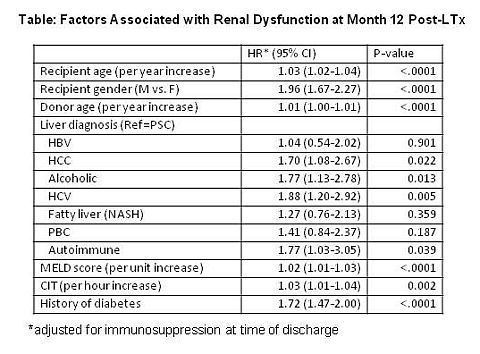Factors Associated with Renal Dysfunction at 12 Months Following Liver Transplantation
CTI Clinical Trial and Consulting Svcs, Raleigh, NC
Novartis Pharmaceuticals Corporation, East Hanover, NJ
Novartis Pharma AG, Basel, Switzerland
Wellman AG, Basel, Switzerland
Meeting: 2013 American Transplant Congress
Abstract number: D1686
Introduction: Renal dysfunction (RD) before and after liver transplantation (LTx) is a significant predictor of graft failure (GF). We investigated the association of donor and recipient factors with RD at 12 months (M12) post-LTx.
Methods: Adult patients in the UNOS database who received a primary LTx from 2002-2011 were eligible. RD was defined as eGFR<30mL/min/1.73m2 or graft loss due to renal failure. Risk factors for RD were evaluated using competing risk survival methods. Multivariable risk factors were identified using stepwise (backward elimination) method.
Results: Out of 33,708 patients with eGFR data at M12, 28,939 had eGFR³30 at time of LTx with no history of dialysis (mean age 54 years; 73% male; 4-year median follow-up). Majority of the patients were transplanted for HCV (31%), HCC (26%) or alcoholic cirrhosis (21%). Mean eGFR (SD) at time of LTx was 86 (41); 42% were in CKD stage 1 (eGFR≥90), 32% in stage 2 (60≤eGFR<90) and 26% in stage 3 (30≤eGFR<60). Cumulative incidence of RD at M12 was 3.2% and varied across liver diagnosis (range=1.6% in PSC to 4.2% in autoimmune cirrhosis; p=0.001). Factors significantly (p<0.05) associated with increased risk of RD include older donors and recipients, male recipients, patients transplanted for HCC, HCV, alcoholic and autoimmune cirrhosis versus PSC, higher MELD scores, prolonged cold ischemia time (CIT) and history of diabetes (Table). Factors not statistically associated with risk of RD included recipient race, recipient body mass index, HLA incompatibility, history of portal vein thrombosis, number of previous abdominal surgeries and medical condition at time of LTx. eGFR at time of LTx was significantly associated with risk of RD (Hazard ratio [HR] per unit increase=0.980; 95% confidence interval [CI]=0.977-0.983) but is highly correlated with MELD score (Correlation = -0.25; p<0.001).

Conclusion: Donor and recipients risk factors for RD at M12 post-LTx were identified. These findings may have important implications for individualized therapeutic strategies.
To cite this abstract in AMA style:
Irish W, Tran M, Escrig C, Ricci J. Factors Associated with Renal Dysfunction at 12 Months Following Liver Transplantation [abstract]. Am J Transplant. 2013; 13 (suppl 5). https://atcmeetingabstracts.com/abstract/factors-associated-with-renal-dysfunction-at-12-months-following-liver-transplantation/. Accessed December 13, 2025.« Back to 2013 American Transplant Congress
